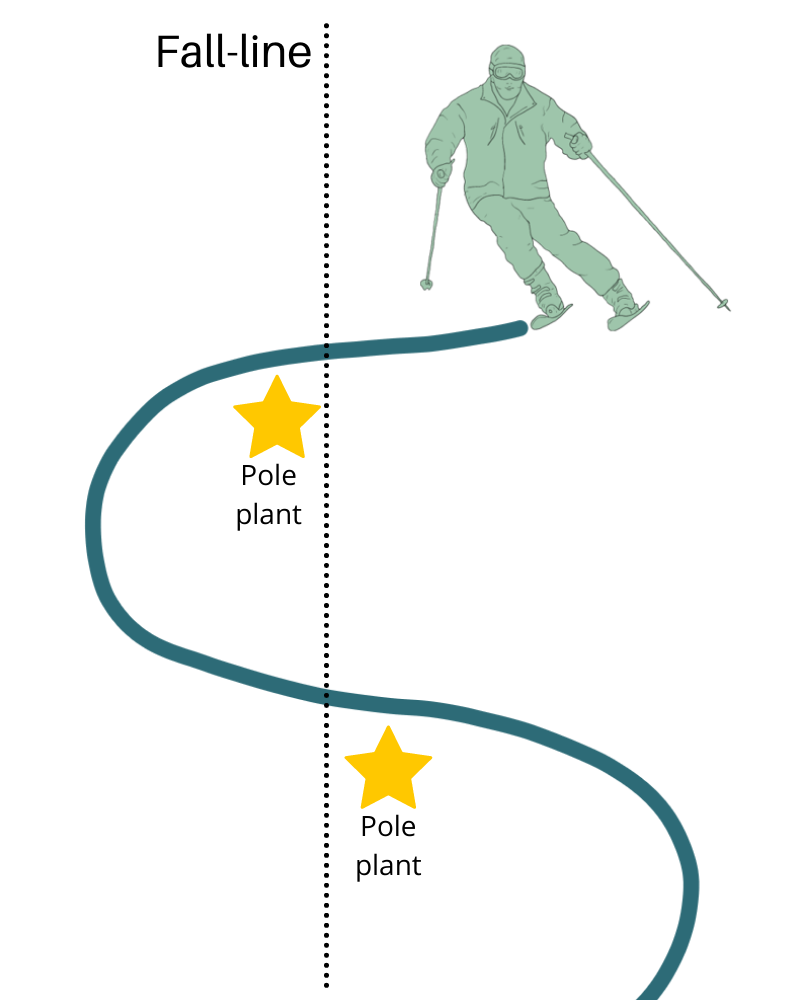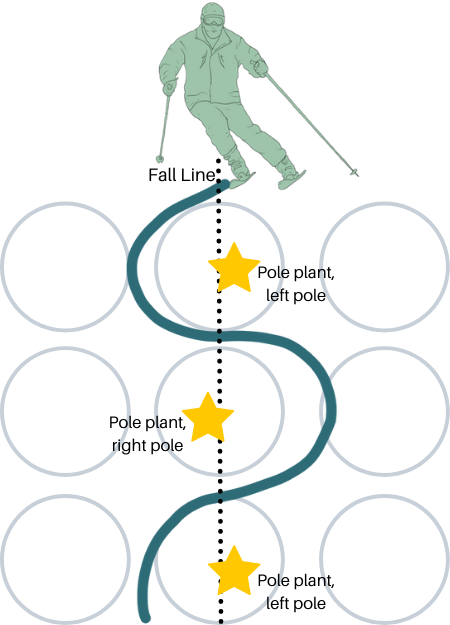Pole planting is an often overlooked part of skiing technique. Many people seem to carry ski poles for decoration, or as a way to better wave at friends from across the trail. Learning to pole plant can significantly improve your skiing.
For beginners, ski poles are both unnecessary and potentially detrimental. They can distract you from your form and posture. Using ski poles incorrectly can also create bad habits you’ll need to break later. They are also one more piece of equipment to drop or get tangled in during falls.

Once you are confident doing parallel turns on at least intermediate terrain, ski poles can become more helpful. For intermediate to advanced skiers, ski poles offer added balance, rhythm, timing, accuracy, and support. You may not need to pole plant, per se, on intermediate cruisers… but, when you start exploring moguls, glades, and super steep trails, you will find a new appreciation for your poles.
Pole planting is especially useful in moguls and glades, where quick turns and careful balance are required. Pole planting helps slalom racers nail their timing through a tightly woven course.
What is the purpose of pole-planting?
In downhill skiing, you control your speed by turning.
The radius of your turn is determined by how fast you want to go, the radius of your ski, the force applied to that ski, and your technique.
A pole plant can help you control the radius of your turn by providing a fulcrum for you to rotate around when you draw a circle using 2 pencils and a paperclip.
Pole planting also helps with the rhythm of your turns. The pole plant marks the beginning of a new turn and can help you time your turns more precisely. The action of planting your ski pole also encourages you to get forward at turn initiation and can help generally with fore-aft balance.
For medium or long radius turns, the pole plant helps mostly with balance and the timing of your turns. For short radius turns, often used in moguls and glades, the pole plant aids you in actually completing the turn.
A pole plant is especially helpful in glades and backcountry skiing. Pole planting can help you finely tune the timing of your turns to help avoid obstacles. It also prepares you to absorb bumps and dips in the snow.
Generally, pole planting encourages you to maintain balance in your upper body. It prevents your upper body from accelerating too fast down the hill, getting ahead of your lower body. On steep terrain, the pole plant provides a third point of contact with the snow (2 skis + 1 pole) during the precarious transition between turns, when you must lean into the fall line to initiate the new turn.
The Importance of Upperbody Positioning
A good pole plant is a very subtle movement. All it takes is a slight flick of the wrist. Before going into pole planting, let’s review where your hands should be while skiing. This applies whether or not you are using ski poles!
Where should your hands be while skiing?
- Hands out in front of you, not at your sides or behind you.
- Elbows a bit wider than your shoulders. Holding your arms out a bit will help with balance.
- Shoulders should be holding your upper arms at a slight angle in front of your body.
- Elbows should be at around a 90° angle, almost like you are carrying a tray of food.
- Arms should be engaged in your athletic stance, but not tense
Your ski poles should be like extensions to your arms, following the angle of your upper arm downwards towards the snow. Your poles should be a bit behind your body.
You want your arms to feel strong, but not tense. Avoid letting your hands drop down near your side pockets, but don’t try to ski with your arms straight out like Frankenstein’s monster either.
The above YouTube video, “The Perfect Ski Posture” from In the Snow, takes an in-depth look at the best posture for downhill skiing.

How To Pole Plant
With your hands and arms in the right position, a pole plant should feel pretty natural. As you are skiing, flick the wrist of your downhill arm, or the arm on the inside of your next turn, to plant your pole right as you are putting your skis on that edge. It should be well after you have completed your last turn, but right before turning to face down the fall line of your next turn.
For example, in a left turn, you would pole plant with your left pole right as your skis start to engage their left edges. Your skis are still pointed slightly to the right, having only just begun to tip towards the fall line.
To plant your pole, it should only require you to slightly flex your left wrist, flicking the pole a bit outwards. You aren’t pushing your pole down into the ground, but extending it out from your arm to meet the ground.
As you transition into the turn, you will move in front of your planted pole, and your pole will release its contact with the ground as you get close to finishing the turn. Be careful not to let your whole arm come behind you as your pole does.
The movement of your pole comes only from your wrist, not the movement of your entire arm, and it is important that your arms stay in front of your body for the entire turn.

During the turn, your pole extends out in front of you to make contact with the snow, and then falls back into its regular position slightly behind you as you move through the turn, almost like a swing.
In the trees, pole plants help you maneuver between obstacles with better control, balance, and timing. In the moguls, pole plants allow you to make tiny turns around the moguls to create a nice zipper line.
When skiing moguls, your pole plant should be on the bump itself, near the center of the mogul but slightly towards the uphill side. This also helps you keep your balance forward while skiing moguls, as it can be easy to get thrown into the back seat in the bumps.
Tips for Proper Pole Plants
For more tips for executing proper pole plants, check out the following youtube video: Ski Tips: Pole Plant with professional skier Dan Egan.
What to remember as you practice pole planting:
Have fun out there! Pole planting should be a positive addition to your general skiing form, not a detriment.
Remember to focus on your overall posture and balance while practicing pole plants.
If you find that trying to remember to pole plant distracts you from skiing your best, ditch the poles for now and work on getting confident turning without them.
Practicing skiing without poles with your arms in the proper position is a great way to prepare for pole planting, and will be beneficial to your overall technique in the long term.
Pingback: Learn to Ski Moguls Like a Pro - Ski Tips